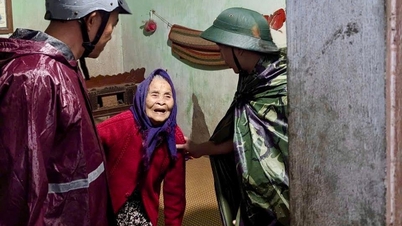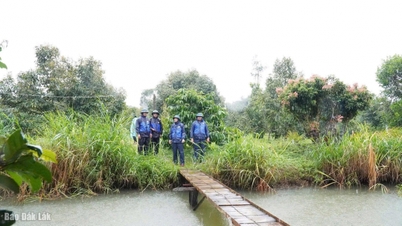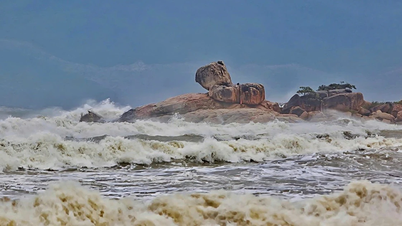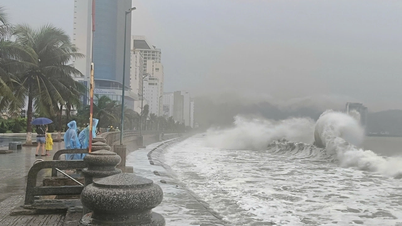At 10:00 a.m. on November 6, the center of the storm was located at about 13.1 degrees North latitude; 111.6 degrees East longitude, about 270km East Southeast of Quy Nhon ( Gia Lai ). The strongest wind speed was Level 15 (167 - 183km/h), gusting to level 17. Forecast: In the next 3 hours, the storm will move mainly in the West direction, at a speed of about 20 - 25km/h. This evening, the storm will be in the sea area from Quang Ngai to Dak Lak.
It is forecasted that from November 6 to 7, the area from Da Nang City to Dak Lak will have very heavy rain with common rainfall of 200 - 400mm/period, locally over 600mm/period; the area from South Quang Tri to Hue City, Khanh Hoa and Lam Dong will have heavy rain with common rainfall of 150 - 300mm/period, locally over 450mm/period.
Warning: Natural disaster risk level 4 - Very dangerous level (Western part of the central East Sea, sea area from Quang Ngai to Dak Lak (including Ly Son special zone); mainland East area from Quang Ngai to Gia Lai.
To ensure the safety of people and property, people need to respond promptly, evacuate when required and absolutely not be subjective, and need to follow the following instructions and recommendations:
BEFORE THE STORM HIT:
1. Regularly monitor forecasts, warnings, and updates on storm and heavy rain developments to proactively prevent and avoid them.
2. Ensure safety of boats at anchorage, protect fishery cages and rafts; absolutely do not stay on moored boats, watchtowers, cages, rafts, or aquaculture areas when affected by storms.
3. Proactively stock up on food, water, medicine, and necessary supplies for several days.
4. Identify the safest shelter for all family members; proactively evacuate when necessary or as required by local authorities.
5. Reinforce and brace houses; trim tree branches; remove billboards and posters that pose safety risks; ensure safety of construction sites.
6. Reinforce barns and farms for raising livestock and poultry; consider moving livestock and poultry to higher locations to avoid flooding.
7. Harvest agricultural products, especially crops and aquaculture areas nearing harvest time to limit damage caused by storms and floods.
8. Keep your valuables high and important documents in a safe place.
9. Move vehicles to higher ground; beware of flooding in apartment basements.
10. Beware of rain, floods, and inundation in low-lying areas, urban areas, and flash floods and landslides in mountainous areas; beware of rising water in coastal areas and river mouths.
11. Proactively clear drainage systems near your home and residential area to create flood escape routes; notify the authorities when there are problems with drainage blockages or deep flooding.
12. Save emergency phone numbers for use in case of emergency. Comply with the instructions of local authorities.
WHEN THE STORM HIT:
1. Regularly monitor the development of storms and heavy rain to proactively prevent and avoid them.
2. Stay indoors, in a safe shelter (keep doors closed, away from windows and glass areas).
3. Absolutely do not go out when the storm is coming, except in an emergency. If you must go out, wear a helmet and bring items such as a flashlight, life jacket, whistle, and phone to contact in case of an incident.
4. Do not take shelter under trees or electric poles. Beware of lightning and accidents caused by objects damaged by storms.
5. Proactively turn off the power source and lock the gas valve to minimize the risk of fire and electric shock in dangerous stormy conditions.
6. Absolutely do not stay on boats, watchtowers, rafts, or aquaculture areas when a storm hits. Do not return until the storm has passed.
7. Note that the time when the storm center enters is usually calm for about 30 minutes - 1 hour, then the wind changes direction and becomes strong again.
8. Beware of rain, floods, and inundation in low-lying areas, urban areas, and flash floods and landslides in mountainous areas; beware of rising water in coastal areas and river mouths.
9. Save the local rescue phone number, promptly and accurately inform the authorities of your location and dangerous situation in case of emergency, especially the 112 switchboard.
10. Comply with the direction of local authorities.
Source: https://quangngaitv.vn/nhung-viec-can-lam-ngay-truoc-khi-bao-so-13-do-bo-6509759.html


![[Photo] Closing of the 14th Conference of the 13th Party Central Committee](https://vphoto.vietnam.vn/thumb/1200x675/vietnam/resource/IMAGE/2025/11/06/1762404919012_a1-bnd-5975-5183-jpg.webp)


![[Photo] Prime Minister Pham Minh Chinh receives the delegation of the Semiconductor Manufacturing International (SEMI)](https://vphoto.vietnam.vn/thumb/1200x675/vietnam/resource/IMAGE/2025/11/06/1762434628831_dsc-0219-jpg.webp)
































































































Comment (0)